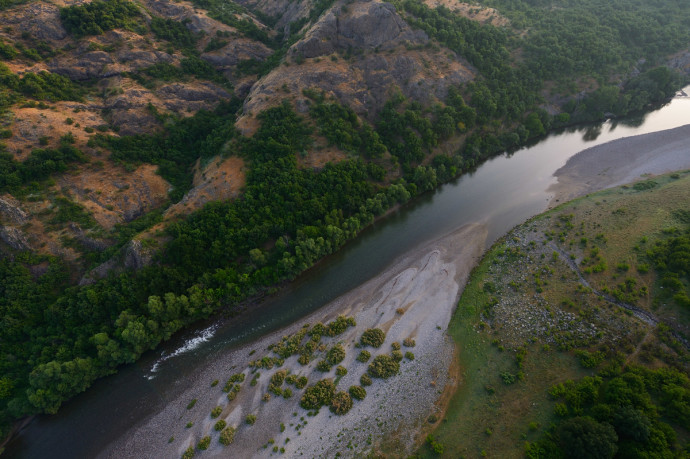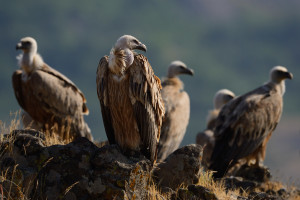“The Eastern Rhodopes are one of the most beautiful places in Europe! You will see!” Frank Zanderink told me, when I was preparing for my internship. Frank Zanderink is the “students’ broker” for Rewilding Europe. I agreed with him silently in my mind when for the first time in my life I saw the beautiful Eastern Rhodopes.

The mountains here are low, but really spectacular. Every twist of the road surprises you with a breathtaking view. Flat slopes and deep narrow valleys extend as far as eyes can see – and the furthermost hills seem almost like a mirage as they are faded blue. Depening on the weather or the moment of the day the mountains always look somehow different: fearfully when misty, gaily when sunny, tranquilly before sunset. You‘ll never see them twice the same!
What is essential about the Eastern Rhodope mountains, it is the wildlife, which is really prosperous. While spending my days here, I saw as many deer as I haven‘t seen anywhere else! When you drive your car through the area, they are just passing through the road or grazing somewhere near. Here you can see wild boars, griffon vultures, wolves (unfortunately, I didn’t succeed to see them yet) and European bison. Now only two of these impressive animals live here and hopefully, after some decades we’ll have a bunch of their descendants! Definitely, one of the most stunning experience for me was seeing wild horses. Those animals are just adorable! Wild, free, and surprisingly curious.
Also, it was a pleasure for me to find out that the Eastern Rhodopes are not only rich in wildlife, but also in cultural heritage. Though I’ve visited only the Thracian stone sanctuary and the antique temple (II BC – III AD) in the village of Tatul, there are much more to discover! All the maps with tourist information suggest you to visit lots of famous sights with an ancient cultural heritage.

Me and my three colleagues who work for rewilding in this area – Hristo, Desi and Stanislav and their dog Shisho – are living in village of Nanovitsa. People here are friendly and relaxed. It‘s a pity that I don‘t speak Bulgarian or Turkish (which is very common here) and I can‘t communicate with locals. Anyway, most of them friendly response to my „zdravejte!“ (hello) and try to speak with me. What more I really like about the people here, they always seem willing to help you. Every time I go for a walk, drivers just stop and suggest to give me a lift. One day it was raining quite heavily, so a guy, who was going the opposite direction, just turned around to take me back home!
My job here is to help the Rewilding Rhodopes team with their everyday duties monitoring the European bison and the wild horses Tarpans. It is more than that. On 29 November 2014, experts and volunteers from the Bulgarian Society for Protection of Birds (BSPB) and Rewilding Rhodopes had a big day. We counted the griffon vultures in the Eastern Rhodopes as apart of the 10th consecutive census of this rare species in the Balkans. The event this year is organized by BSPB and the Vulture Conservation Foundation (VCF) in partnership with 14 other nature conservation organizations and institutes from Bulgaria, Greece and Serbia. The census was carried out by more than 35 teams in the Balkans.
The counting day in the Rhodopes was a sunny and warm Saturday afternoon. We had 17 teams, formed mostly from two people. Most volunteers were young students of biology or ecology. They all love nature, enjoy being there and helping to deal with come up problems. Every team was standing in a different spot around the area where vultures live. All the day we were watching how many vultures are hanging around and every team had to make notes: what time how many vultures they saw and which direction the birds were moving. When it was getting dark, the birds prepared to sleep: they landed on the rocks and that was the time when we could count the exact number of vultures.
Unfortunately, me and my colleague Sylvia didn’t count any vultures in our spot, only those several that were passing by. However, for me it was an unforgettable experience: I saw what does it mean to count this kind of birds, also me and Sylvia we were enjoying each others company and lovely surroundings – low but scenic mountains, grazing sheep, cows and donkeys. We attracted a lot of attention from the local people, who were really interested in what we are doing and why we are standing all the day with the telescope and binoculars. One old man even asked weather we had somewhere to stay: „I live nearby, so if you have no shelter, you are very welcome at my home. It‘s not luxurious, but we‘ll find some place for you“ he suggested.
In the evening all counters went to the Vulture center in the town of Madzharovo. Every team announced their results and then we calculated the total number of vultures. The total number was 144 vultures, 91 of them were adult. That is 10 vultures less than last year. Bulgarian landscapes and rural areas are suitable for griffon vultures, so hopefuly the population of the species will be increasing and soon will fully recover. It would be great to see a big number of vultures flying over the large fields and grazing herds in the mountains!
That’s how the life goes on here in the Eastern Rhodopes. Sometimes it seems to me that time here just stopped: changes come slow, yesterday looks almost the same as today and probably tomorrow. You can just relax and enjoy the moment!
You can be an active part in supporting the rewilding activities in the Rhodope Mountains! Help us to help the susliks to come back in numbers and to re-colonise the lands where they used to live, in the foothills of the Rhodope Mountains of Bulgaria.
